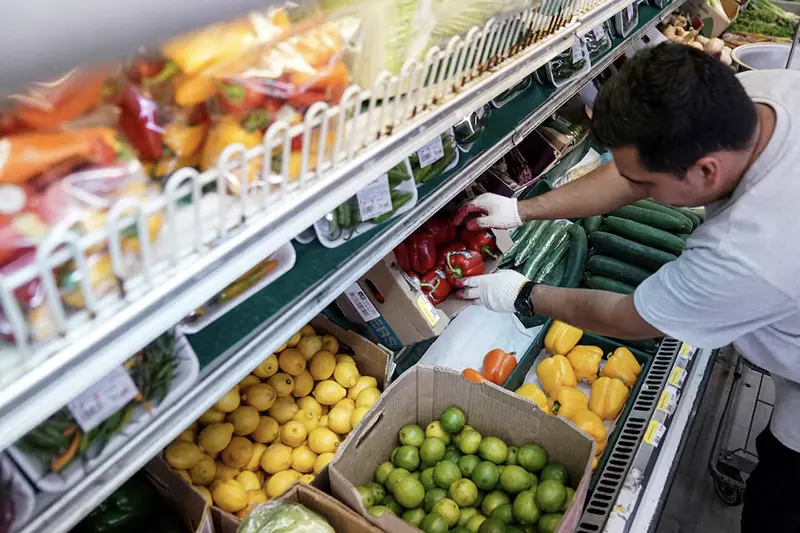🔴 Website 👉 https://u-s-news.com/
Telegram 👉 https://t.me/usnewscom_channel
October 10, 2024 – 8:11 AM PDT
WASHINGTON (Reuters) – U.S. consumer prices rose slightly more than expected in September amid higher food costs, but the annual increase in inflation was the smallest in more than 3-1/2 years, keeping the Federal Reserve on track to cut interest rates again next month.
Advertisement
Other data from the Labor Department on Thursday showed first-time applications for unemployment benefits surged last week to the highest level in more than a year, boosted by Hurricane Helene and a nearly four-week-old strike at Boeing (BA.N), which has forced the U.S. planemaker to furlough workers and impacted suppliers. The strike and hurricanes could distort the labor market picture this month.
Despite the firmer-than-expected monthly inflation reading last month, a sharp moderation in rent increases led economists to expect a more muted rise in the main inflation measures tracked by the U.S. central bank for its 2% target.
“The September CPI rose more than expected, but the details do not suggest enough acceleration to sway the Fed from a 25 basis points rate cut next month,” said Will Compernolle, macro strategist at FHN Financial. “While there were some components that showed concerning acceleration, the slowdown in shelter inflation bodes well for future cool core services prices.”
The consumer price index increased 0.2% last month after gaining 0.2% in August, the Labor Department’s Bureau of Labor Statistics said. Food prices jumped 0.4% after rising 0.1% in August. Grocery store food prices increased 0.4%, lifted by higher costs for meat, poultry, fish and eggs. Fruits and vegetable prices rebounded 0.9% after dropping 0.2% in August.
But consumers got some relief from gasoline prices, which plunged 4.1%. Rents increased 0.3% after climbing 0.4% in the prior month. In the 12 months through September, the CPI rose 2.4%. That was the smallest year-on-year increase since February 2021 and followed a 2.5% advance in August.
Economists polled by Reuters had forecast the CPI edging up 0.1% and rising 2.3% year-on-year. The annual increase in inflation has slowed from a peak of 9.1% in June 2022.
Inflation is a major issue for voters in next month’s presidential election. Vice President Kamala Harris, the Democratic Party’s nominee, is locked in a tight race with the Republican Party’s candidate Donald Trump.
The Fed has mostly shifted focus to the labor market, delivering an unusually large 50 basis points rate cut in September. Minutes of that meeting published on Wednesday showed a “substantial majority” of policymakers supported beginning an era of easier monetary policy with an outsized cut, but there appeared even broader agreement that the initial move would not commit the Fed to any particular pace of rate reductions in the future.
The first rate reduction since 2020 lowered the central bank’s policy rate to the 4.75%-5.00% range. The Fed hiked rates by 525 basis points in 2022 and 2023.
U.S. stocks opened lower. The dollar was little changed against a basket of currencies. U.S. Treasuries were mixed.
WEATHER DISTORTIONS
Financial markets saw a roughly 87% probability of a 25 basis points rate cut at the Fed’s Nov. 6-7 policy meeting, according to CME Group’s FedWatch Tool. The odds of rates being unchanged were at about 13%.
Investors abandoned hopes for another half-percentage point rate reduction next month against the backdrop of continued labor market resilience and solid consumer spending.
The economy added the most jobs in six months in September and the unemployment rate fell to 4.1% from 4.2% in August.
There are also some pockets of stickiness, which are slowing the pace of cooling in underlying inflation.
Excluding the volatile food and energy components, the CPI increased 0.3% in September after rising 0.3% in August. The so-called core inflation was driven by a rebound in the prices of used cars and trucks. Healthcare costs rebounded 0.4%, pushed up by a 0.9% surge in the cost of doctor services.
Motor vehicle insurance increased 1.2%, while apparel prices advanced 1.1%. Airline fares cost 3.2% more. But owners’ equivalent rent, a measure of the amount homeowners would pay to rent or earn from renting their property, gained 0.3% after rising 0.5% in August.
In the 12 months through September, the core CPI advanced 3.3%. That followed a 3.2% gain in August.
In a separate report, the Labor Department said initial claims for state unemployment benefits increased 33,000 to a seasonally adjusted 258,000,for the week ended Oct. 5, the highest level since early August 2023.
The increase was the largest since July 2021. Economists had forecast 230,000 claims for the latest week.
Unadjusted claims soared 53,570 to 234,780 last week. They were boosted by a 9,490 jump in claims in Michigan, which has a heavy presence of Boeing suppliers.
Applications shot up 8,534 in North Carolina and rose 3,843 in Florida. Helene, which tore through Florida and devastated large swathes of the U.S. Southeast in late September, is likely to continue distorting claims data in the weeks ahead.
The labor market’s short-term outlook is also likely to be distorted by Hurricane Milton, which barreled through Florida on Thursday, whipping up deadly tornadoes, destroying homes and knocking out power. The roughly 33,000 machinists at Boeing (BA.N) who walked off the job last month could negatively impact October’s employment report.
Economists expect Fed officials will discount any sharp decline in payrolls or rise in the unemployment rate in October.
The number of people receiving benefits after an initial week of aid, a proxy for hiring, increased 42,000 to a seasonally adjusted 1.861 million during the week ending Sept. 28, the claims report showed.
“Today’s data shouldn’t raise concerns as both data points remain relatively low compared to history,” said Eugenio Aleman, chief economist at Raymond James. “In the wake of recent labor strikes and natural disasters, we might see jobless claims increase further over the next few weeks.”
Reporting by Lucia Mutikani; Editing by Chizu Nomiyama and Andrea Ricci
Advertisements below
